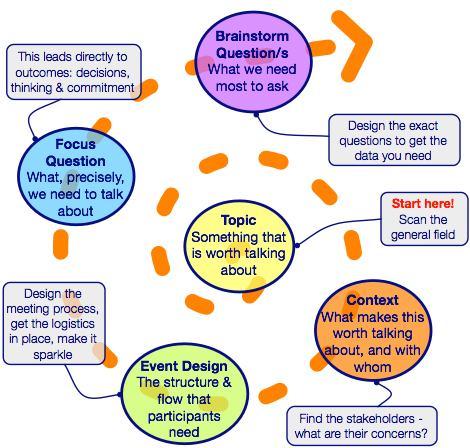Planning a project meeting
A well planned meeting requires a commitment to excellent outcomes based on good preparation and strong design skills.
I’m using meeting here to mean any kind of project conversation where the outcome matters. On one hand it includes workshops and phone calls. On the other, it is not dependent on participant numbers or on technology.
The diagram below is a kind of route map for preparing and designing meetings. It takes you on a journey from an ‘emergent’ topic that is making itself known, such as a problem, change request, risk, opportunity, to a point where you can start a meeting with confidence.
Each step along the way is critical to success. Like walking, they flow from one to the next. The first two are about figuring out what the situation needs: why are you meeting? The last three are about designing your event: how are you meeting?
What’s the real topic to be discussed?
- What research have you done to explore and validate it? Why would people want to come together and work with on that topic?
- What’s in it for you and for them?
What’s the specific context? Getting clear on all this is often an iterative process. It does have to be done and it doesn’t have to take a long time. It is definitely time well spent.
- What is driving the topic? What events or forces are happening beyond the immediate concerns that make this topic important right now?
- Who are the stakeholders, and what are their needs and interests with respect to the topic? How do you find out about those needs and interests and take them into account? Which of those stakeholders will be part of the actual meeting?
With the event design, it’s the agenda and all the mechanics. This is about making it happen, going beyond tips, tricks and methods to a session that gets the group to a robust result.
- What meeting process (this looks like an agenda or a running sheet) will you use?
- What logistics (like catering and pens) are required?
- How will you engage people make the meeting sparkle?
The focus question distill all the factors into a common reference point. It directs the attention of the group to the precise topic.
- If they go off topic, you use that question to draw them back into line.
- What are the practical (tangible outputs), rational (new thinking/awareness) and experiential (how people will be different) outcomes?
With the brainstorm question/s, it’s about eliciting the information you actually need.
- What information, processed in what way will deliver your outcomes?
- Garbage in, garbage out. An oldie but a goodie. No amount of high falutin’ processing is going to fix up crap data.
Planning is one half of a good meeting; running it is the other half. So, what’s your experience of a well planned meeting? Please, add your thoughts below.


